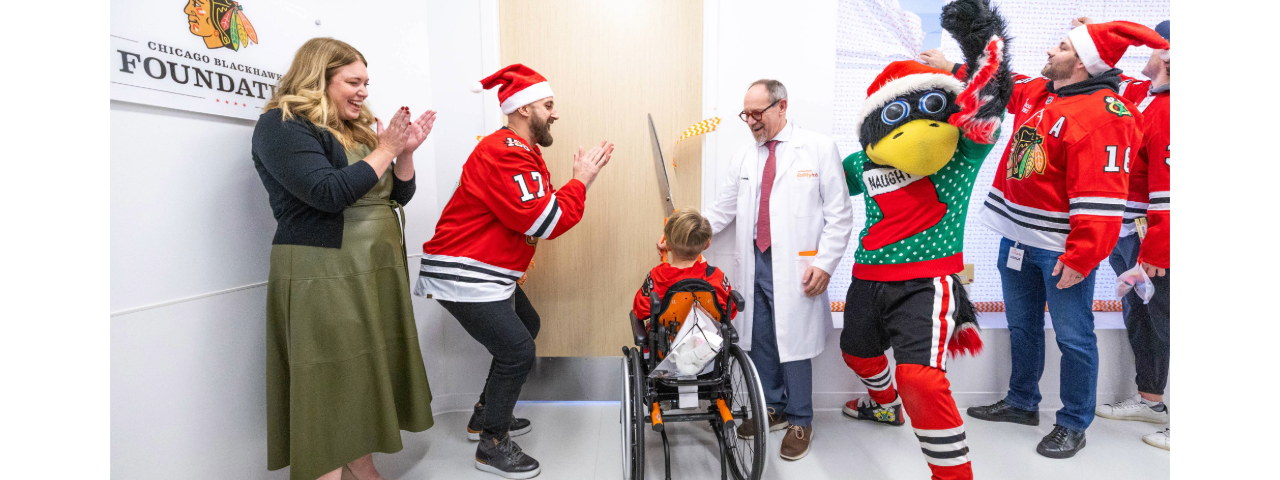Body
“Good morning,” the nurse says, entering the room.
“Hello, how are you feeling today?” the doctor asks.
“Good morning,” the patient replies. “I’m feeling OK, but I’ve noticed something…”
The physician is real. The RN is real, too. But the patient isn’t real, and this conversation isn’t taking place in a patient room. Instead, it’s in the Patient Simulation Lab — commonly called the “Sim Lab” — on the 12th Floor. The “patient” is a robotic manikin in a wig, and its voice belongs to Pam Pfeifer, RN, clinical nurse manager. Pam is sitting in the Simulation Lab Control Room, separated from the nurse, doctor and manikin by a one-way mirror. She is reading a script that corresponds to a medical scenario, while cameras record the interaction in the next room.
What Is the Sim Lab?
Body
Simulations like this enable clinicians to log realistic medical experience and hone their diagnostic skills in a safe, controlled environment. It’s like a flight simulator for physicians, nurses and pharmacists, enabling them to “pilot” patient situations for training.
In the old RIC building, simulations were “low fidelity,” consisting of group discussions or scenarios with volunteers acting as stand-ins for patients.
With the move to the Shirley Ryan AbilityLab in 2017 and the opening of the Sim Lab, simulations became realistic and “high fidelity” — conducted with high-tech, programmable manikins.
“Priority is given to what we refer to as ‘high risk/low volume’ situations for our clinical staff,” Pam said. “We simulate situations that they are less likely to experience so that they can gain practice managing them.”
It’s like a flight simulator for physicians, nurses and pharmacists, enabling them to 'pilot' patient situations for training.
Body
In the old RIC building, simulations were “low fidelity,” consisting of group discussions or scenarios with volunteers acting as stand-ins for patients.
With the move to the Shirley Ryan AbilityLab in 2017 and the opening of the Sim Lab, simulations became realistic and “high fidelity” — conducted with high-tech, programmable manikins.
“Priority is given to what we refer to as ‘high risk/low volume’ situations for our clinical staff,” Pam said. “We simulate situations that they are less likely to experience so that they can gain practice managing them.”
Meet the Sim Lab Manikins
Body
There are two manikins in the Sim Lab: one is an adult, the other is a baby (for pediatric clinical practice). The adult-sized manikin can be made male, female or gender-neutral.
The manikins can produce just about any patient scenario imaginable. They can be programmed to have different pulses, blood pressures and pulse oximetries. They breathe, cough and wheeze. There are audible heart, lung and abdominal sounds, both normal and abnormal. They have reactive pupils, can seize, cry, froth at the mouth, leak fluid from the ears, and allow for oral or trach ventilation. They can receive CPR and be defibrillated or paced. They can have a tension pneumothorax and abdominal distention. They can be catheterized, be given IM/IV/IO injections, and clinicians can administer medications to them.
“The most common ‘symptom’ scenarios we’ve done so far are cardiac-respiratory arrest, seizure, autonomic dysreflexia, storming, contrast dye (allergic) reaction, sepsis and LVAD emergencies,” Pam said.
Special Thanks
Body
The Sim Lab was established with a generous campaign gift from the Tellabs Foundation and dedicated in memory of Michael J. Birck, co-founder and former chairman and CEO of Tellabs, a global network technology provider. In addition to providing campaign support, the Tellabs Foundation has supported the Shirley Ryan AbilityLab's Assistive Technology program.

